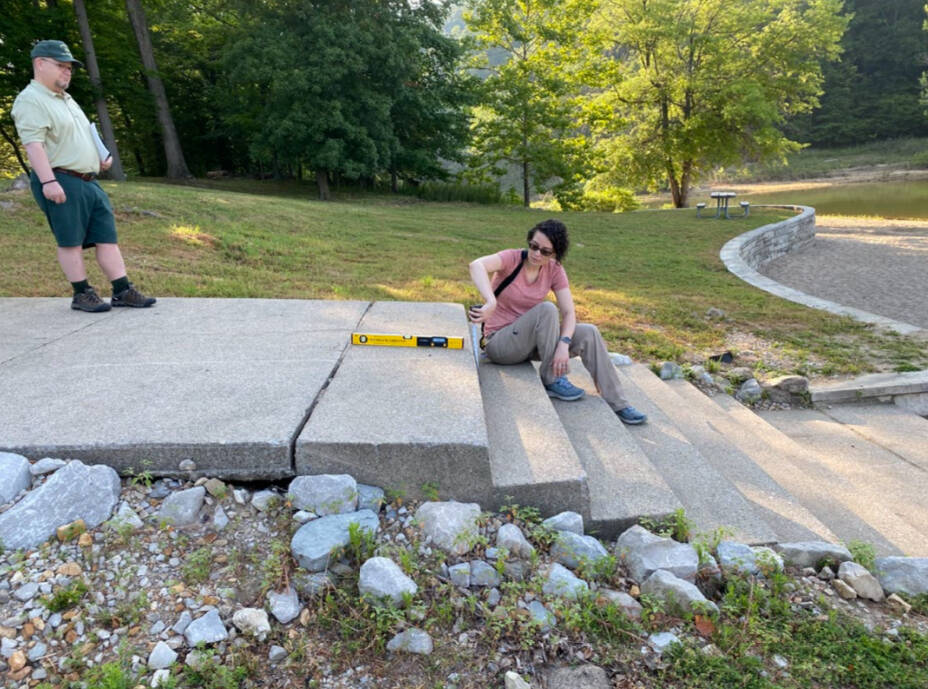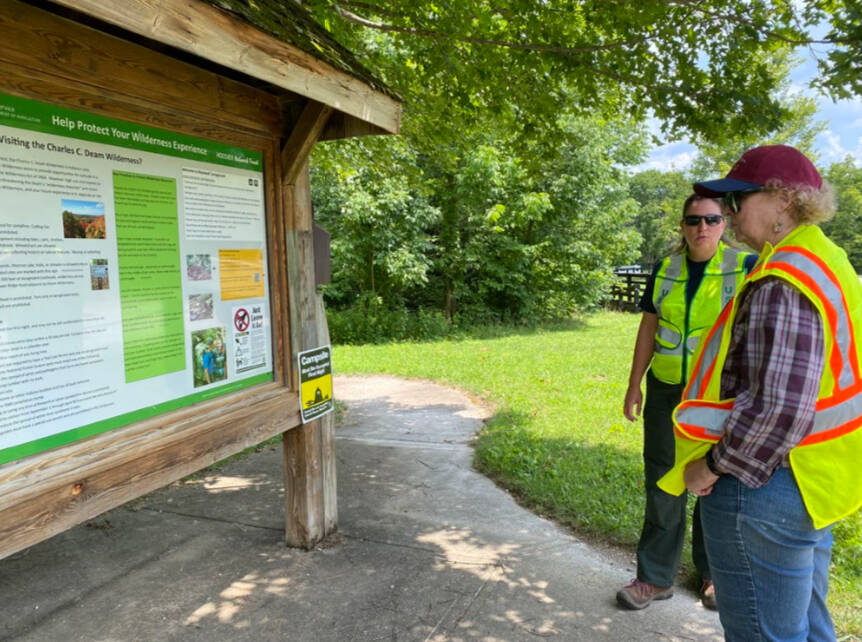
Hoosier National Forest civil engineer, Michael McBride, looks on as Indiana University Eppley Center for Parks and Public Lands research associate, Kris Brethova, measures for accessibility. (USDA Forest Service photo by Quentin Melson).

Retired Forest Service civil engineer, Donna Sheehy, inspects a Charles C. Deam Wilderness sign as Hoosier National Forest recreation, public affairs, and partnerships staff officer, Stacy Duke, listens to her recommendations. (USDA Forest Service photo by Quentin Melson).
Hoosier National Forest staff in Indiana recently partnered with Indiana University accessibility experts and Forest Service signage experts to identify ways to make the national forest more accessible to people of all abilities.
“Every day, we work diligently to better accommodate visitors of all abilities,” said Stacy Duke, Hoosier National Forest recreation, public affairs and partnerships staff officer. “Working with the Indiana University Eppley Center for Parks and Public Lands and Forest Service sign experts helps us do that.”
According to a news release from the Forest Service, in June, staff with the Hoosier National Forest met with staff from the Eppley Center and its national center on accessibility program and Stone Belt, a local non-profit organization that provides resources and support for individuals with disabilities, to determine ways to make recreating on the national forest more accessible for all people.
Staff from the Eppley Center visited recreation sites on the Hoosier National Forest and measured everything from bathrooms to beach access.
“The National Center on Accessibility program at the Eppley Center reviewed numerous visitor experiences at Hoosier National Forest,” said Colleen Durkin-Blackburn, senior program manager of accessibility and park planning at the Eppley Center. “Some of the specific components included accessible parking, pathways, trails, restrooms, scenic areas, picnic areas, lodging, water access and many others. These components were assessed to identify if improvements would be beneficial.”
The Forest Service entered into a partnership with the Eppley Center in 2023 to help improve the agency’s accessibility program and enhance the accessibility of forest service outdoor recreation areas.
After taking notes and measurements related to accessibility standards, the Eppley experts met with forest officials and leaders from Stone Belt, a Bloomington nonprofit group, to discuss their findings.
The group discussed many possible improvements, including the addition of Mobi-mats so that forest visitors who use a wheelchair could access the beach. Mobi-mats are portable beach access mats that provide firm, stable surfaces for wheelchair or walker users, or for anyone with mobility considerations.
“Mobi-mats are good because not only would they help someone using a walker or wheelchair, but they could also benefit anyone who feels a bit unsteady,” said Bitta DeWees, CEO of Stone Belt. “
Most things that you do to benefit people with disabilities tend to benefit the general population as well,” she said.
Hoosier National Forest leadership responded positively.
“We’re looking forward to acquiring Mobi-mats so that the Hardin Ridge beach area can be enjoyed by all,” Duke said.
The accessibility assessment site visit is part of a multi-year national partnership between the Forest Service and the Eppley Center’s program to not only improve access, but streamline internal processes, modernize assessment methods and improve training.
As part of an ongoing effort to improve forest access, in July, Forest Service employees at the Hoosier National Forest met with agency signage experts to raise awareness of the importance of signs and to improve signage consistency so that the forest can be better enjoyed by all.
“Signage and placement are important on the Hoosier National Forest because it keeps users safe and educates the public,” said Hannah Wanderling, Hoosier National Forest civil engineer and unit sign coordinator.
She went on to describe how each type of sign serves a unique and important purpose.
“Transportation-related signs prevent vehicle accidents,” Wanderling said. “Guide signs aid users to their destinations; interpretive signage educates interested forest visitors; and kiosks and maps provide guidance on remote locations, conservation practices and potential risks while visiting the forest.”
Forest leadership invited signage experts such as Donna Sheehy, a retired Forest Service civil engineer, to share information, investigate potential signage issues and brainstorm for solutions.
“In many ways, signs are the face of the Forest Service,” said Sheehy. “More than anything else, signing can either enhance or diminish the quality of a forest visitor’s experience.”
After three days of an on-the-ground investigation of Forest Service signs around Hoosier National Forest, the sign assistance trip was deemed a success.
“It was great for us to be able to tour the Hoosier National Forest with Forest Service staff and look at each type of sign and examine sign placement on the ground, in-person,” Sheehy said. “We were better able to interpret signage issues and offer solutions due to being out in the field, using a hands-on approach.”
By inviting accessibility experts to assess the forest’s accessibility and inviting signage experts to help improve Forest Service signs and sign placement, staff at the Hoosier National Forest did their part in continuing the U.S. Forest Service’s mission to connect all Americans to the outdoors, including persons with disabilities.
